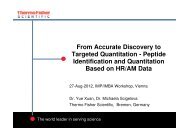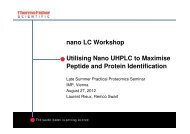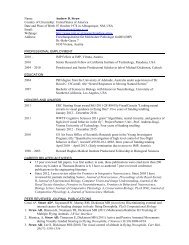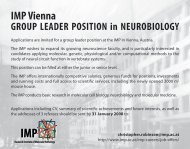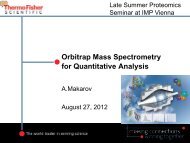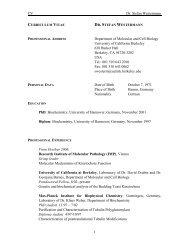IMP Research Report 2002
IMP Research Report 2002
IMP Research Report 2002
You also want an ePaper? Increase the reach of your titles
YUMPU automatically turns print PDFs into web optimized ePapers that Google loves.
Figure 2: In ovo gain-of-function experiment with chick using retroviral injections to investigate the potential role of different factors in skeletogenesis.<br />
(A) Injections of retroviral particles are performed at day 3.5 of chick embryonic development into the posterior half anlage of the future wing (w).<br />
(B) Schematic drawing of the injected limb bud (injected region is colored blue). (C) Visualization of the infection two days after the injection, shown by<br />
the blue staining. (D) Visualization of morphological changes six days after the injection, showing the effects of the gain-of-function experiment on the<br />
skeletal elements of the right (R) wing while the left (L) wing is unaffected (cartilage elements are stained blue).<br />
a role in mouse skeletogenesis at all using a conditional<br />
gene targeting approach. Recent reports have<br />
implicated Wnt-signaling in the control of bone<br />
development and maintenance (Hartmann and Tabin,<br />
2000; Kato et al., <strong>2002</strong>). In particular, we are interested<br />
in analyzing potential roles of Wnt4 and Wnt14 in bone<br />
homeostasis using both, chick and mouse.<br />
Synovial joint development<br />
Our recent analysis of the role of Wnt14 in chick<br />
skeletogenesis has identified Wnt14 as a major player<br />
in the induction process of synovial joint development<br />
(Hartmann and Tabin, 2001). However, in various cell<br />
culture systems, Wnt14 alone is unable to induce the<br />
Figure 3: Section through the joint of a chicken knee. Cartilage is<br />
stained in red, soft tissue is stained greenish, perichondrium (P)<br />
and ligaments (L) in the joint are stained in dark blue.<br />
same responses as in ovo. Thus, we are trying now to<br />
establish an in vitro co-culture system in order to identify<br />
co-factors required for the induction of markers<br />
characteristic of the early joint interzone.<br />
We are also investigating whether Wnt14 is necessary<br />
for joint development in the mouse model system. In<br />
addition, since Wnt14 continues to be expressed in<br />
synoviocytes of the mature joint, we would like to<br />
determine whether Wnt14 plays a role in maintaining<br />
joint integrity. This late expression of Wnt14 is very<br />
interesting in light of joint diseases associated with<br />
alterations of the synovium, such as rheumatoid- or<br />
Our long-term goals are to identify regulators as well<br />
as target genes of Wnt14. Using a transgenic approach<br />
in combination with searching for evolutionary highly<br />
conserved genomic regions within the Wnt14 locus we<br />
are attempting to identify regulatory elements<br />
responsible for the expression in the early joint<br />
interzone. The identification of such a joint specific<br />
element will provide a useful tool to address the question<br />
which factors are necessary for initiation and regulation<br />
of Wnt14 in the joint forming region and will inevitably<br />
allow us to understand how the skeleton is patterned.<br />
osteoarthritis. We are currently addressing potential late<br />
function(s) of Wnt14 in the joint using gain- and lossof-function<br />
experiments.<br />
Contact: hartmann@imp.univie.ac.at<br />
23




